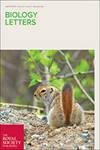海鸟的触觉喙尖器官表明一种深层鸟类共形现象得以保存。
IF 2.8
2区 生物学
Q2 BIOLOGY
引用次数: 0
摘要
鸟类的喙是它们与外界接触的主要触觉界面。与专门觅食技术相关的喙尖触觉器官存在于多个鸟类类群中,但在大多数支系中仍未得到充分研究。其中一个例子是奥氏海鸟,它是由信天翁形目(信天翁和海燕)和企鹅形目(企鹅)组成的主要海鸟支系。在这里,我们描述了奥氏前颌的机械感受器排列和神经血管解剖。通过对现存鸟类(361种)进行广泛的系统发育取样,我们发现信天翁和企鹅表现出复杂的触觉喙尖解剖结构,可与已知喙尖器官的鸟类相媲美,尽管它们并不使用触觉觅食。海燕(栉水母科、水蝠科和大洋蝠科)缺乏这些形态,这表明栉水母科内部的喙尖机械敏感性在进化过程中发生了转变。奥氏腹角鸟的喙尖器官可能与夜间觅食、水下发现猎物或求偶表演有关,其中涉及喙的触觉刺激。或者,这些器官可能是残余的,大多数古鼻类动物(如鸵鸟和鸸鹋)可能就是这种情况。祖先状态重建未能否定奥氏爬行鸟最后的共同祖先具有喙尖器官的假说;因此,触觉觅食可能是这一现存主要支系的祖先,也许是从冠鸟进化史的更深阶段保留下来的。本文章由计算机程序翻译,如有差异,请以英文原文为准。
Tactile bill-tip organs in seabirds suggest conservation of a deep avian symplesiomorphy.
Birds' bills are their main tactile interface with the outside world. Tactile bill-tip organs associated with specialized foraging techniques are present in several bird groups, yet remain understudied in most clades. One example is Austrodyptornithes, the major seabird clade uniting Procellariiformes (albatrosses and petrels) and Sphenisciformes (penguins). Here, we describe the mechanoreceptor arrangement and neurovascular anatomy in the premaxillae of Austrodyptornithes. Using a wide phylogenetic sample of extant birds (361 species), we show that albatrosses and penguins exhibit complex tactile bill-tip anatomies, comparable to birds with known bill-tip organs, despite not being known to use tactile foraging. Petrels (Procellariidae, Hydrobatidae and Oceanitidae) lack these morphologies, indicating an evolutionary transition in bill-tip mechanosensitivity within Procellariiformes. The bill-tip organ in Austrodyptornithes may be functionally related to nocturnal foraging and prey detection under water, or courtship displays involving tactile stimulation of the bill. Alternatively, these organs may be vestigial as is likely the case in most palaeognaths (e.g. ostriches and emu). Ancestral state reconstructions fail to reject the hypothesis that the last common ancestor of Austrodyptornithes had a bill-tip organ; thus, tactile foraging may be ancestral for this major extant clade, perhaps retained from a deeper point in crown bird evolutionary history.
求助全文
通过发布文献求助,成功后即可免费获取论文全文。
去求助
来源期刊

Biology Letters
生物-进化生物学
CiteScore
5.50
自引率
3.00%
发文量
164
审稿时长
1.0 months
期刊介绍:
Previously a supplement to Proceedings B, and launched as an independent journal in 2005, Biology Letters is a primarily online, peer-reviewed journal that publishes short, high-quality articles, reviews and opinion pieces from across the biological sciences. The scope of Biology Letters is vast - publishing high-quality research in any area of the biological sciences. However, we have particular strengths in the biology, evolution and ecology of whole organisms. We also publish in other areas of biology, such as molecular ecology and evolution, environmental science, and phylogenetics.
 求助内容:
求助内容: 应助结果提醒方式:
应助结果提醒方式:


